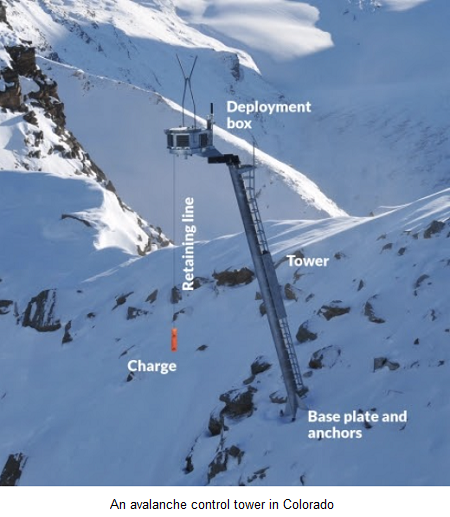The Colorado Department of Transportation (CDOT) is using new remote technology, which is tower-based, to control avalanche-prone areas. The Journal reported that one location, above the highway between Rico and Lizard Hill Pass that’s prone to avalanches, is now equipped with five 30-foot-tall towers that lower explosive charges on a tether.
According to CDOT maintenance supervisor Todd Jones, the systems were provided by Wyssen Avalanche Control of Switzerland and offer a safer and more efficient way to mitigate avalanche danger for travelers. “This system is a more versatile tool for controlling these slide paths that run pretty often,” he said.
How often? The Journal reported that one area, the Yellow Springs, Yellow Wall, and Peterson slide paths, experiences natural avalanches several times per week or even per day. Some avoid highways, but others do not.
“Our main goal is to bring down smaller avalanches frequently to avoid a large natural one,” Jones said. The remote control system reduces traffic delays, he added and can be used at night or in low visibility during storms. Other avalanche management solutions require daytime only executions, according to The Journal.
The tower project cost CDOT $1.4 million but came at a good time because it has been an especially dangerous winter. According to Becca Hodgetts, forecaster for the Colorado Avalanche Information Center (CAIC), extreme avalanche conditions seen this year occur about once every decade. Since 1991, the two agencies, CDOT and CAIC, have partnered to keep highways safe and have avoided any fatalities for 30 years.
The new tower system, which was tested for the first time last week, makes avalanche control safer and more efficient for crews and the public. During the test, crews blocked traffic in both directions to maintain safety, spotters watched for secondary avalanches from various locations, and an operator detonated explosives from afar via cell phone.
The Journal reported that CDOT operates more than 30 remote control avalanche systems at several locations on high mountain highways and the Interstate Highway 70 corridor. Between CDOT and CIAC, the agencies monitor and control about 278 of 522 known avalanche paths above Colorado highways.
The avalanche tower, made by Wyssen, a Swiss company, triggers the avalanche through a coded command sent from the control center in Switzerland to the control system of the deployment box to initiate the blasting. The deployment box contains 12 prepared explosive charges, which can be individually deployed by remote control. When the explosive charge is dropped, two igniters are pulled and the explosion is set off after a time delay. The charge remains hanging from a cord at a pre-set height above the snow cover, which is completely dropped after blasting. To reload explosive charges the complete deployment box is lifted from the tower by helicopter and brought to a station building or warehouse respectively.
Watch a controlled avalanche north of Rico, CO, here.





Reader Interactions